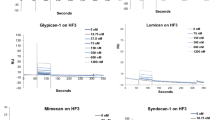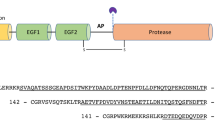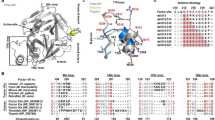Abstract
An old puzzle in protein biochemistry1 concerns the ready conversion of ovalbumin, by proteolysis, to the much more stable derivative, plakalbumin. Ovalbumin is now known to belong to the serpin superfamily2,3, most of which are serine proteinase inhibitors. We report here studies of two such members of the family, the human plasma proteins α1-antitrypsin and antithrombin, and show that they undergo a similar change in stability on selective proteolysis. This change, which is accompanied by a loss of inhibitory activity, can best be considered as an irreversible molecular transition from a native stressed (S) conformation, to a more ordered relaxed (R) form. The maintenance of the native S conformation, and hence the maintenance of inhibitory activity, is critically dependent on the integrity of an exposed loop of polypeptide. We propose that the susceptibility of this peptide loop to proteolytic cleavage gives it an incidental role as a physiological switch which allows the inactivation of individual inhibitors by specific proteolysis. The vulnerability of this exposed loop in each inhibitor also explains the pathological action of a number of venoms and toxins. In particular, the demonstration here of the cleavage of antithrombin, by leukocyte elastase, explains an observed change in blood coagulation that accompanies severe inflammation and which can result in fatal thrombosis.
This is a preview of subscription content, access via your institution
Access options
Subscribe to this journal
Receive 51 print issues and online access
$199.00 per year
only $3.90 per issue
Buy this article
- Purchase on Springer Link
- Instant access to full article PDF
Prices may be subject to local taxes which are calculated during checkout
Similar content being viewed by others
References
Linderström-Lang, K. & Ottesen, M. Nature 159, 807–810 (1947).
Hunt, L. T. & Dayhoff, M. O. Biochem. biophys. Res. Commun. 95, 864–971 (1980).
Carrell, R. W. & Travis, J. Trends biochem. Sci. 10, 20–24 (1985).
Löbermann, H., Tokuoka, R., Deisenhofer, J. & Huber, R. J. molec. Biol. 177, 531–556 (1984).
Johnson, D. & Travis, J. Biochem. J. 163, 639–641 (1977).
Linderström-Lang, K. & Ottesen, M. C.r. Lab. Carlsberg Ser. Chim. 26, 403–442 (1948).
Ottesen, M. C.r. Lab. Carlsberg Ser. Chim. 30, 212–269 (1958).
Wright, H. T. J. biol. Chem. 259, 14335–14336 (1984).
Jochum, M., Lander, S., Heimburger, N. & Fritz, H. Hoppe-Seyler's Z. physiol. Chem. 362, 103–112 (1981).
Owen, M. C., Brennan, S. O., Lewis, J. H. & Carrell, R. W. New Engl. J. Med. 309, 694–698 (1983).
Weiss, S. J. & Regiani, S. J. clin. Invest. 73, 1297–1303 (1984).
George, P. M., Vissers, M. C. M., Travis, J., Winterbourn, C. C. & Carrell, R. W. Lancet ii, 1426–1428 (1984).
Brower, M. S. & Harpel, P. C. J. biol. Chem. 257, 9849–9854 (1982).
Rosenberg, S., Barr, P. S., Najarian, R. & Hallewell, R. A. Nature 312, 77–80 (1984).
Courtney, M. et al. Nature 313, 149–151 (1985).
Carrell, R. Nature 312, 14 (1984).
Kress, L. F., Kurecki, T., Chan, S. K. & Laskowski, M. Sr J. biol. Chem. 254, 5317–5320 (1979).
Kress, L. F., Catanese, J. & Hirayama, T. Biochim. biophys. Acta 745, 113–120 (1983).
Morihara, K., Tsuzuki, H., Harada, M. & Iwata, T. J. Biochem., Tokyo 95, 795–804 (1984).
Virca, G. D., Lyerly, D., Kreger, A. & Travis, J. Biochim. biophys. Acta 704, 267–271 (1982).
Tanaka, T., Ohkubo, H. & Nakanishi, S. J. biol. Chem. 259, 8063–8065 (1984).
Banda, M. J., Clark, E. J. & Werb, Z. J. clin. Invest. 75, 1758–1762 (1985).
Author information
Authors and Affiliations
Rights and permissions
About this article
Cite this article
Carrell, R., Owen, M. Plakalbumin, α1-antitrypsin, antithrombin and the mechanism of inflammatory thrombosis. Nature 317, 730–732 (1985). https://doi.org/10.1038/317730a0
Received:
Accepted:
Issue Date:
DOI: https://doi.org/10.1038/317730a0
This article is cited by
-
Serpins in rice: protein sequence analysis, phylogeny and gene expression during development
BMC Genomics (2012)
-
Regulation of the epithelial Na+ channel and airway surface liquid volume by serine proteases
Pflügers Archiv - European Journal of Physiology (2010)
-
Serpins' mystery solved
Nature (2008)
-
Serpins in plants and green algae
Functional & Integrative Genomics (2008)
-
Structure of a serpin–protease complex shows inhibition by deformation
Nature (2000)
Comments
By submitting a comment you agree to abide by our Terms and Community Guidelines. If you find something abusive or that does not comply with our terms or guidelines please flag it as inappropriate.



